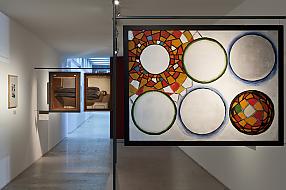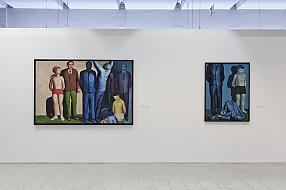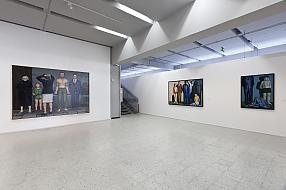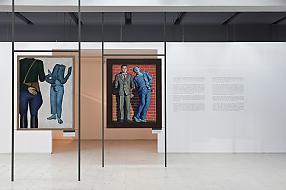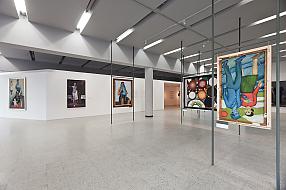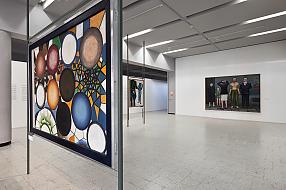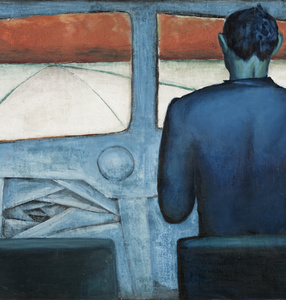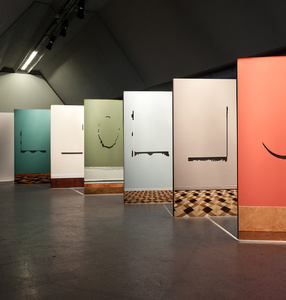Andrzej Wróblewski: Recto / Verso
1948–1949, 1956–1957
Andrzej Wróblewski (1927-1957) is one of the most important Polish artists of the 20th century. Wróblewski was a creator of formal experiments on the border of abstraction and figuration, an artist manifesting an unusually suggestive vision of war and human degradation, based on deep political commitments. His rich, diverse body of work was created over a very brief period (less than ten years), during a distinctly turbulent era.
The exhibition “Andrzej Wróblewski: Recto / Verso. 1948–1949, 1956–1957” concentrates on two phases in his work: its very beginning, when the artist was trying to come up with his own painterly language (1948–1949) and its very end when, after a period of faith in Stalinist socialist realism and voluntary submission to its mandatory guidelines, he attempted to redefine himself, as if starting from scratch again (1956–1957). These two phases are connected in Wróblewski’s art, both in subject and form, by a unique and highly personalized approach to modernity and the avant-garde. His numerous double-sided paintings and works on paper created in these periods are the material sign of his being torn between political engagement and artistic experiment.
The narrative of the exhibition is based on Wróblewski’s double-sided works, which are usually exhibited one side at a time, with that choice of side decided upon by the paintings’ owners and curators. The artist’s use of both sides of these canvases or the paper works was not an accident or coincidence, or purely the result of an economic situation. Double-sidedness was a sort of program for Wróblewski and a fitting symbol for all his work: he made the two sides complete one another, and question and complicate the other. This type of dual coexistence, of what are most often extremely different statements both formally and content-wise, is also a pointed way of addressing viewers, who have to literally take sides, while at the same time accepting the existence of both images as two complex problems and two solutions. It is also an expression of the conviction that an artist is an active participant in reality, with the goal of his or her art being the proposal of temporary solutions.
The exhibition's additional selection of works on paper and single-sided canvases show the same key motifs being expanded and enriched by Wróblewski at a given juncture in his work. The multilayered divisions, so materially present in Andrzej Wróblewski’s art, embody the philosophical questions and artistic answers that arose after the Second World War; while his lack of compromise in facing irreconcilable contradictions and ideological demands makes his work particularly relevant in our contemporary situation.
“Andrzej Wróblewski: Recto / Verso, 1948–1949, 1956–1957”is the first exhibition on the artist of a retrospective scope to be curated by a non-Polish scholar. It is the result of a research seminar and international conference dedicated to Andrzej Wróblewski that were organized in the Muzeum Sztuki Nowoczesnej in Warsaw in 2012 and 2013. Éric de Chassey, curator of these events and of the upcoming exhibition, is a prominent scholar of postwar painting, the director of the French Academy in Rome – Villa Medici since 2009, and a professor of the history of modern art at the École normale supérieure in Lyon. Éric de Chassey is the author of many publications on European and American postwar art – research that was brought together in the ground-breaking exhibition “Starting from sctach, as if painting had never existed before,” organized in late 2008 at the Musée des Beaux-arts in Lyon (France).
The exhibition is accompanied by a series of meetings with artists (i.e. Luc Tuymans, Wilhelm Sasnal, Marek Sobczyk, Oskar Dawicki, Andrzej Wajda) and an extended educational programme for children, youth and adults.
The exhibition is also accompanied by “Andrzej Wróblewski. Recto/Verso” – a publication by Éric de Chassey and Marta Dziewańska, published as part of the “Museum under Construction” series.
The coorganizer of the exhibition is Museo Nacional Centro de Arte Reina Sofia, in cooperation with Andrzej Wróblewski Foundation and Adam Mickiewicz Institute.

